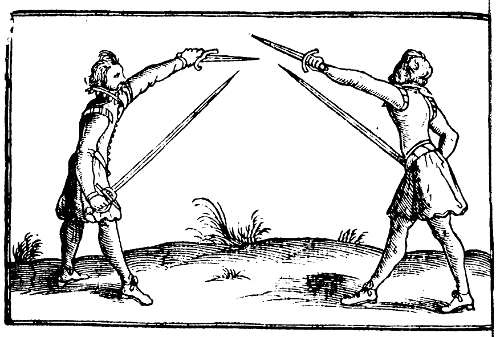This is part of an ongoing project to summarize and provide SCA focused commentary on The Schoole of the Noble and Worthy Science of Defence by Joseph Swetnam, published in 1617.
For links to the other sections of the Swetnam Project please go here.
I am using this facsimile: http://tysonwright.com/sword/SwetnamSchooleOfDefence.pdf for the project.
This first subsection of chapter twelve introduces us to the basic guard for the Rapier and Dagger
The true guard for the defence, either of blowe, or thrust, with Rapier and Dagger, or Sword and Dagger.
Keep your rapier hand inline with the pocket of your hose, without bending the elbow, while your dagger hand should be inline with your left cheek, with your arm outstretched (not bowing the elbow), and with your rapier and dagger points within two or three inches of each other. Make sure that you can see your opponent clearly, and that your left arm is high enough not to obscure your view – you should be able to see your opponent with both eyes. Keep your opponent centered between your rapier and dagger.

Have your head angled slightly toward the right shoulder, and have your shoulders square to your opponent, slightly tilted forward. Keep your thumb on the nail of your fore finger, rather than upon the blade of your weapon (which was the current fashion) so that you have a more secure grip upon your sword. The heel of your right foot should be in line with where your toes meet your foot.
Use the picture as an example, but if there is a discrepancy follow the words, not the picture.
Keep your sword so the quillons are perpendicular to the ground so that you can easily defend with the edge of the blade. The edge is the strongest part of the blade. Do most of your defense with this.
Swetnam then says he will explain the reason for this position. He says that you must insure that the hand, foot, and body positions all be right or else none of it will work. You need to fit this with the rest of his instruction or it will be useless. In order for your practice to be perfect you need to frequently re-read his manual, or you will fall into old habits.
If you break yourself of old habits and practice what Swetnam has laid down then he says you will learn best. If after you choose to return to previous habits that is fine.
The best way to get your feet into a proper place for defense and offense is to stand with your back to a wall and have a friend stand twelve feet away. Then place your left heel against the wall and your right foot’s heel against the large joint on your left foot. From this position step forward with your right foot and extend your hand, but keep your left foot in place like an anchor. When you recover let your right foot go to where is comfortable. Once you do this a few times you will find the correct position for your right foot. If you don’t do this then your left foot will always be creeping away into another position.
With your body and weapons in this position if your opponent attacks you can defend with both your rapier and dagger together. This gives you more protection of your head and makes it very difficult for your opponent to disengage or coupe or to power through your attack (remember that this was designed to defend against the backsword as well as other rapiers). If you defend with your dagger only the blow may glance off of it and still hit you. Once you have defended, drop your rapier point to point about thigh level, then step in and thrust at the same time(lunge). This allows you to make a fast answer before your opponent can recover his guard.
Swetnam reminds us again that while in guard your feet need to be as close together as you can manage. Although he says this he seems to allow for the feet to be up to shoulder width apart. This is where the practice comes in. He wants you to keep your feet close together so that you can make your explosive lunge, but he doesn’t want your feet so close together as to loose your balance. If you are right handed your right foot must be forward, and vice versa for left handed fencers.
Look for where your opponent is “most unguarded”, and remember to attack by both stepping forward with your front foot and moving your right hand forward, but you must return always to your guard after every attack. Keep as much weight as you can on your hind foot, so that no matter how you lunge you always have one foot planted solidly. And when moving remember to step so that you always have a solid footing.
When in guard keep your thighs close together, and keep your front knee bowing backward while your body bows forward. The more you “hollowest thy body” the better. I think he means here that your butt needs to be pushed back to balance you with your shoulders pushed forward. This way you can parry your opponents blade before it gets close enough to do you damage.
And a final note that under no circumstances should you allow your dagger arm to come too far back, or else you won’t be able to use your dagger to defend against a thrust. By this I assume he means that when you parry with the dagger and then lunge you need to make sure that your dagger hand moves forward with you. This will both keep your face safe, and will push your opponents weapon further away from you.
It’s an interesting guard. I used it a little bit and it is such a departure from our standard stance that I found it awkward. It seems to be the stance of someone with great speed. A natural counter-puncher. Once I realized that his admonitions about foot positions come down to ensuring that your feet are no more than shoulder width apart rather than right against each other it made more sense. The biggest change is facing your opponent with squared shoulders and having the blade hand low and forward.
I think that it’s similar to Luther’s demi-refuse stance he uses. Square up instead of putting the left shoulder forward, and bring the hand straight forward as far as you can without lifting it and you should have a similar position. The foot positioning isn’t as weird as I thought it was. Once you realize that he doesn’t mean for your feet to be touching, and he wants you to have your back foot at about a 45 degree angle it makes a lot more sense.
The reasons of this guard.
First, because the points of your weapons are close together your enemy can not strike you with a cut from the wrist, which could otherwise go between your blades. Also the thrust from prime is defended against in this way.
If your rapier is below your dagger then it will get in the way of your dagger as you try to defend with it. Swetnam explains this for a little bit, but it’s fairly self explanatory. You don’t want your weapons to get in the way of each other.
He continues by explaining that you need to make sure that your defense and offense happen at the same time. If you wait too long then the moment of greatest opening will have passed. When your opponent attacks is when he is most vulnerable. Remember when you attack not to drop or pull back your dagger or you will be just as open as your opponent.
The focus on dagger use is what interests me here. He treats the dagger as an integral part of the guard instead of just a defense of last resort. I like that. The low sword position feels too open to me, perhaps I should raise my sword a bit as it’s about 4″ shorter than the one he would have been using, I think the important part is to have your tips almost touching.
A thrust may be defended foure waies.
 The first way is with the dagger. Turning the point down and turning the arm without bending the elbow allows you to turn away a thrust and keep your dagger in essentially the same place.
The first way is with the dagger. Turning the point down and turning the arm without bending the elbow allows you to turn away a thrust and keep your dagger in essentially the same place.
The other way to defend against a thrust with your dagger is to bring the hilt of your dagger down to the level of your waist (girdle-steed is the word Swetnam uses and it’s awesome) with the point upright and move your blade away from your body, pushing your opponents blade to the side.
The third way to defend against a thrust is with your rapier. This also works if the thrust is aimed at your dagger hand and you don’t have a “close hilted dagger”. Draw back your dagger and stretch out your rapier forward and to the left, keeping your point on target.
That’s a great description of an interception parry in quarte.
The fourth way to defend a thrust is with both weapons together. There are three ways of doing this, either with your points up or down.
The first way with the points up is to parry with dagger and sword high and pushing the enemies blade to the left, it’s a combination of the previous interception parry and adding in your dagger for added protection.
The other way is to bring your rapier up to the outside of your dagger (I assume with your palm facing your left side), and bring your dagger in to make a cross against the middle of your rapier about breast height with your dagger in it’s usual place. Once you’ve turned the thrust aside, drop the tip of your rapier toward your opponent and force your opponent’s blade away and down with your dagger while you thrust. This pass off parry works well against the thrust of a staff as well.
He makes a note that when fighting against a staff you must always use both weapons to defend against a blow, and then must close the distance quickly. There is no long fight against the staff either in range or time. If you have a rapier and dagger and your opponent has a staff you must end the fight quickly or he will win.
As soon as your opponent’s lunge has been turned aside you must strike.
At this point I need to break this into multiple sections. The next section will cover the holding of the rapier, and the section after that several passes (passing lunges).



1 Comment
» Thoughts on Reading Swetnam Tomas de Courcy · June 29, 2012 at 3:12 pm
[…] Now next followeth the skill of weapons, and first the true gard of rapier and dagger for the defenc… […]
Comments are closed.